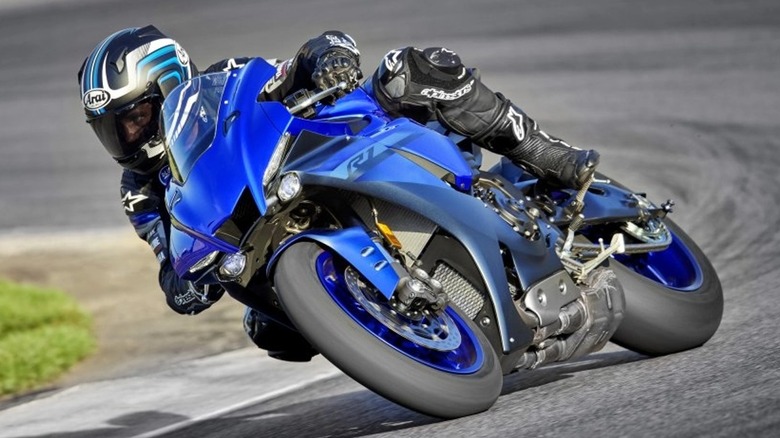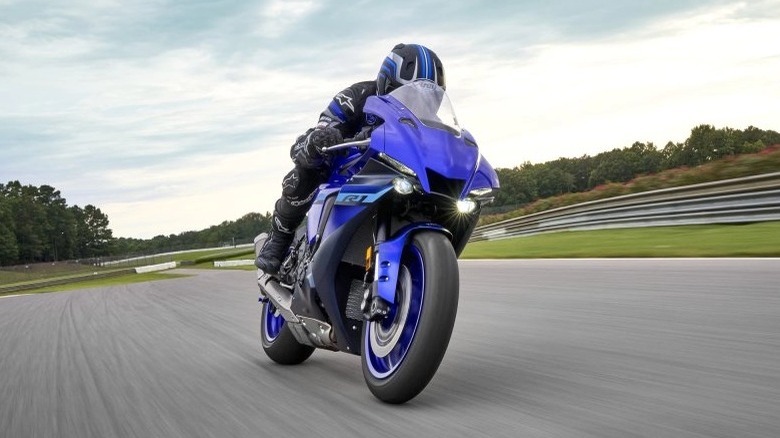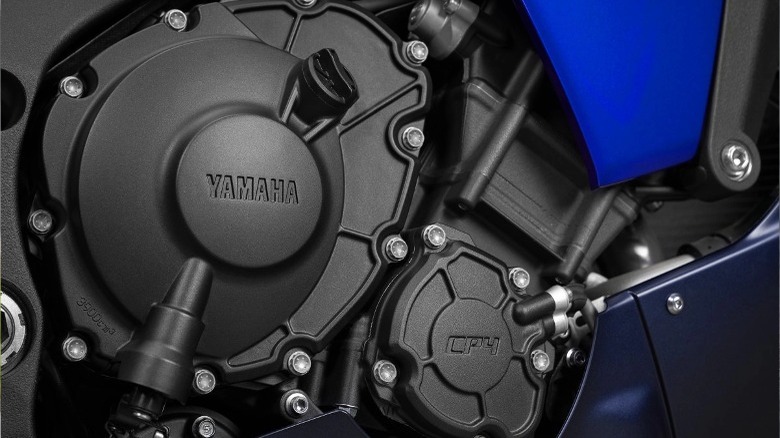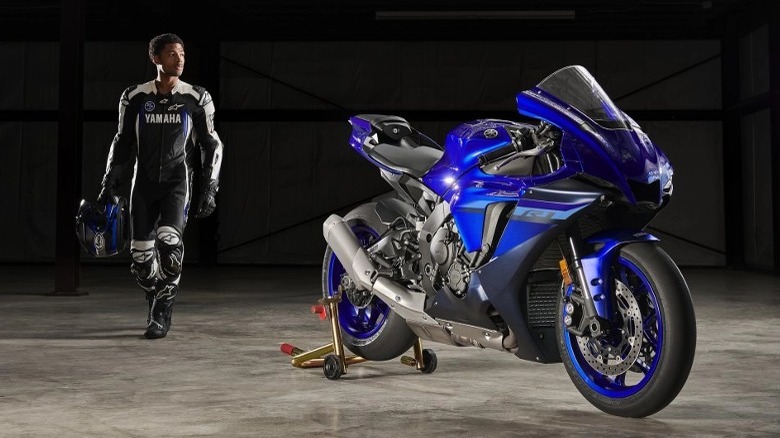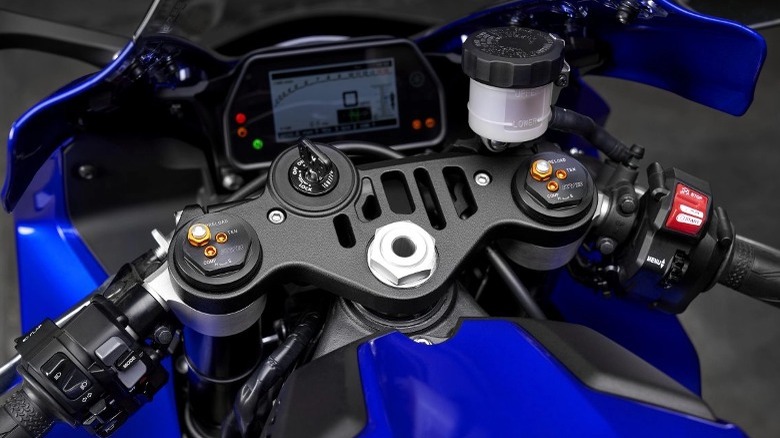All About The 2024 Yamaha YZF-R1 Motorcycle
Yamaha has announced the YZF-R1 sport bike will be making a return as part of its upcoming 2024 lineup. This probably doesn't come as a surprise. There are few names in the motorcycle industry that command as much respect as Yamaha — particularly when it comes to sport bikes. The company has frequently been listed as one of the best manufacturers of performance motorcycles, and it's the third best-selling motorcycle brand in the world after Honda and Hero Motor. A study performed by Consumer Reports in 2015 found that it's the most reliable brand on the market, so it's always exciting when a new Yamaha bike makes its debut.
The YZF-R1 isn't a new model by any means. The R1s are the fastest motorcycles Yamaha ever built. They have much bigger engines than the R3, R6, and R7 motorcycles, so it's no shocker that the R1 series has been one of the more popular Yamaha models to grace the road and racetrack since the company first introduced it in 1998, but that doesn't mean Yamaha's engineers have been resting on their laurels. Each iteration has marked improvements as Yamaha has sought to integrate the latest innovations in its vehicles. These involve everything from adding horsepower and torque to fuel efficiency and aerodynamics. So what changes will we see in the 2024 model? Here's everything we know about it so far.
How much will the YZF-R1 cost?
The first thing that many who are considering buying the new Yamaha YZF-R1 will want to know is how much it costs. Getting a shiny new bike is all well and good, but it's important to know if the price has gone up by a significant amount since the previous year.
The 2024 YZF-R1 is currently listed to start at $18,399. This is a $400 increase on the 2023 model which is still available at $17,999, but it seems to be reasonable when compared to the current market.
This price is comparable to the 2024 Suzuki GSX-R1000R which will sell for $18,499 and the BMW S 1000 RR which is going for $18,295. Suzuki and Yamaha have similarly specced street bikes, so it makes sense that they would have similar prices. These three are marginally undercut by the 2024 Honda CBR1000RR which has a base MSRP of $16,699, but all of these sports bikes are significantly more expensive than the 2024 Kawasaki Ninja 1000SX ABS which costs a mere $13,699. This definitely puts Yamaha on the more expensive end of the spectrum, but not unreasonably so.
What kind of engine will the YZF-R1 have?
One of the most important aspects of any motorcycle is the engine, but it's also one of the most expensive components to design, manufacture, and test. This means that most companies will use a successful engine model for years between upgrades. These changes are so profound that they typically mark a generational shift, begging the question: Is the 2024 YZF-R1 getting a new engine?
Sadly, that doesn't appear to be the case this year. The 2024 model will use an iteration of the same CP4 998cc, liquid-cooled 4-cylinder DOHC engine that has powered the R1 series since 2015, making this the longest-running generation in the R1's history. This design is starting to show signs of its age as the newer models on offer from some of Yamaha's competitors like Honda and Suzuki have been steadily closing the gap in performance, but there is a reason it's lasted as long as it has.
The Yamaha 998cc Inline-4 is still considered by many racetrack aficionados to be one of the best engines in its size bracket. This inline engine has four valves per cylinder, a 79.0mm bore and 50.9mm stroke, and a 13.0:1 compression ratio. It's fuel-injected and comes with a 6-speed transmission, wet multi-plate assist, and a slipper clutch. But one of its biggest features is Yamaha's exclusive crossplane crankshaft technology. This tech was initially designed for the racetrack, making it so that Yamaha's YZR-M1 MotoGP would internally balance and equalize inertial forces. This gives the rider a more direct feeling of linear torque during acceleration.
What changes will be made to the YZF-R1 design?
Another thing to consider with newer models is changes to its outer appearance and structure. This can involve anything from variations in seat height to different kinds of brakes or even new fork structures.
The 2024 YZF-R1 hasn't changed much from the 2023 model, however. Both have a 43mm KYB inverted front fork and a KYB single shock rear suspension. Both have dual 320mm hydraulic disc front brakes and a 220mm hydraulic disc back brake. They come stock with the exact same Bridgestone tires. The fuel capacity is the same, the weight is the same, and even the dimensions are identical.
There are a few design changes, but they are much more subtle. Both still offer both blue and black options, but there appear to be a few slight changes in the paint job and the shaping of the outer fairings to identify the new model. Even taking that into account though, there isn't much to separate the 2023 and 2024 models on the outside. A majority of the innovations that define this new model come down to its feature set.
What features will the YZF-R1 have?
There are several key features outside of the YZF-R1's design and raw performance that help to set it apart from its contemporaries. In addition to the crossplane crankshaft, the CP4 engine has titanium connecting rods and intake valves, allowing riders to safely push it further into the redline. It has a high-performance intake system to enhance throttle performance, compact rocker-arm actuation to reduce friction losses, and a titanium exhaust system.
In terms of electronics, the YZF-R1 has a special chip-controlled throttle system. Yamaha states that this is, "built around the Accelerator Position Sensor with Grip (APSG), which eliminates the throttle cables ... YCC-T precisely senses throttle input by the rider and actuates the throttle valves to actively control intake volume, allowing for cutting-edge computerized engine management but in a lighter package." Yamaha also makes a chip for its variable intake system. This adjusts the "length of the intake based on engine speed" to broaden the spread of power and keep acceleration feeling smooth and even across the RPM range of each gear. Then there's Yamaha's Inertial Measurement Unit. This "combines a gyro sensor and G-sensor accelerometer that measures all six axes of movement in 3-D space at a rate of 125 calculations per second." It does this to collect information about the motorcycle's position and then send that information to the Engine Control Unit, "which then powers the R1's rider-assisting technology package" in order to provide a smoother and more stable ride.
